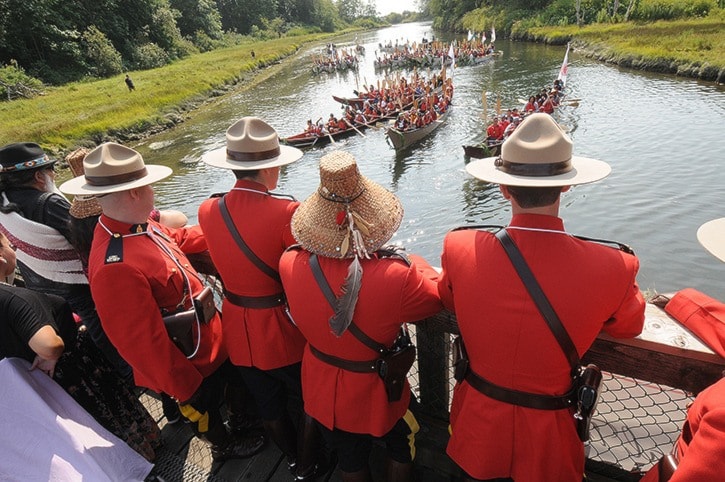As the first canoe pulled level with White Rock pier, after rounding the breakwater, it was in hailing distance of strollers and sightseers on the pier.
"It's good to see the war canoes out again," one called out.
"These aren't war canoes," came the voice of one the paddlers below, chuckling, as they maintained a steady pace heading for the beach.
Indeed as, one-by-one, some 21 flag-decorated canoes came to rest on the shore, and paddlers alighted and pulled them, with the help of some bystanders, further up the beach, it was clear that this was a moment, far from thought of confrontation, of quiet contemplation and satisfaction at successful teamwork.
The arrival at the pier around noon on July 10 marked the end of the next-to-last leg of the 2015 Pulling Together Canoe Journey – an eight-day, 100-mile trip involving representatives of many B.C. First Nations along with paddlers from several police forces including the RCMP and the Vancouver Police Department, and CN Rail, a major sponsor of the event.
It was a chance to enjoy a quiet lunch with friends and family – and rest before the final leg of the journey, paddling the short distance to the Semiahmoo First Nation lands for the ceremonial arrival and an evening of feasting and celebration.
It was also an opportunity to chat informally with Mayor Wayne Baldwin and other members of White Rock council who had come to the beach to welcome the canoeists.
And it was also a chance, as Const. Troy Derrick, Surrey RCMP First Nations Policing officer confessed, for him to slip back to the detachment for a shave and to get cleaned up prior to the welcoming ceremonies at Semiahmoo for which he would don the dress red serge of the force.
He'd been paddling with the canoes since this year's journey started, on July 2, at Harrison Lake in the territory of the Sts'ailes First Nation. The route of the canoeists had passed through Sumas and down the Fraser to the Lower Mainland, also including Deas Island and Tsawwassen, before heading to Crescent Beach and then to Semiahmoo Bay.
"We travelled three kinds of water, from the lake to the river and then to the Salish Sea," he said.
"It was a good paddle," he added, talking about the most recent segment of the trip. We started from Crescent around 8:30 a.m. – it was easy."
The Pulling Together Canoe Journey, which began in 2001, traces it's roots back to a 1997 vision quest organized by now-retired RCMP Staff Sgt. Ed Hill, in which officers and First Nations paddlers visited many nations down the coast of B.C.
For Derrick, the journey, in which he has participated for the past nine years, is doubly significant – both as an RCMP member and as someone of First Nations heritage, from the Gitxsan Nation.
For him it's a shared experience of two minority groups – both First Nations and police – who are both perceived through stereotypical images perpetuated by media.
"This is only the second time the canoes have put in here in the last 100 years," he noted. "That's very significant. For a long time anything like this would have been illegal."
But this year's journey was also about individuals – including at-risk First Nations youth – challenging themselves, while being part of a larger group, he said.
"There are about 500 people involved in the journey, but also 500 journeys involved," he said. "This year's theme is HealThy Ways – healthy ways for the total group, but also heal-thy-ways, for the individual."
Derrick said the journey is, in many ways, symbolic of a positive, cooperative way of life that can bring together many different groups and nations.
"When you're out there, everyone else is relying on you and you're relying on everyone else."
Semiahmoo First Nations councillor Roxanne Charles, who was lead paddler of her own canoe for several segments of the journey, pointed with pride to the fact that SFN had three canoes in the event.
She said the trip was eased by being billeted with the Sts'ailes and Kwantlen first nations for several days, while Semiahmoo hosted the paddlers over a five day period.
"The youth involved are doing amazing – they feel totally at home in the canoes," she said.
She also acknowledged the participation of the Department of Fisheries and Oceans and CN Rail to this year's journey.
"CN made a huge contribution to Pulling Together as well as helping Semiahmoo host this year," she said.
"It's neat to see everyone building strong relationships."
